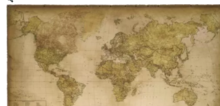In an age where satellites provide real-time imagery of every corner of Earth, it’s surprising how many people still long for the aesthetic of old cartography. The carefully drawn coastlines, sepia tones, and whimsical details bring a sense of nostalgia. Collectors, designers, and even educators often turn to retro-style continent maps as a way to blend artistic heritage with geographic knowledge, creating a powerful balance of function and beauty.
Part of the appeal lies in how these visuals make you feel. They don’t just present information; they tell stories. Looking at retro-style continent maps can make one imagine what it felt like centuries ago when explorers set sail not knowing what lay beyond the horizon. The faded colors, elaborate borders, and ornate compass roses encourage viewers to step outside the modern mindset and experience a slower, more imaginative world.
Artists and interior decorators have also embraced the trend. Many contemporary homes feature a statement wall adorned with retro‑style continent maps as a way to create warmth and character. Instead of sterile digital projections, these maps bring history into the home, encouraging conversations and curiosity. A single glance at such a piece can transform a plain room into a place where culture and heritage live side by side.
Educationally, they have their own value too. While modern maps may prioritize accuracy and updated borders, retro-style continent maps invite students to think critically about the evolution of geography. They prompt questions like: How did people once view the world? What details were exaggerated or missing? In this way, retro maps don’t just show geography—they provide lessons in history, sociology, and even art.
Collectors of antiques understand their power well. For them, retro-style continent maps are not just décor but treasures that preserve craftsmanship. Each stroke of ink on a historical replica speaks to an era where maps were painstakingly drawn by hand. Owning one is like owning a piece of human curiosity, representing an enduring desire to understand and interpret the world around us.
The design community, particularly in publishing and branding, has also tapped into this timeless charm. When businesses want to convey heritage or authenticity, they often incorporate imagery from retro-style continent maps into their packaging, marketing campaigns, or editorial designs. This is because maps convey trust, exploration, and history—values that many brands want to highlight.
Travelers, too, are drawn to them. Before setting out on modern adventures, some people enjoy gazing at retro-style continent maps to daydream about journeys across deserts, mountains, and oceans. They serve as a reminder that exploration is not new; it is deeply embedded in human history. Even though GPS leads the way today, the romanticism of past voyages still inspires the modern wanderer.
Digital creators have not been left behind in this wave of nostalgia. Graphic designers and illustrators frequently recreate the feel of retro-style continent maps with modern tools, blending old aesthetics with new techniques. These digital versions often appear in video games, websites, or educational apps, ensuring that the antique appeal continues to evolve alongside technology.
Psychologically, there’s something deeply comforting about them. In a world overflowing with rapid updates, retro-style continent maps allow us to pause and breathe. They remind us of the long history behind human exploration, encouraging reflection instead of just data consumption. This emotional connection makes them more than just visuals—they become portals into imagination.
As trends come and go, one truth remains clear: the fusion of art and geography will always hold value. Whether displayed in a home, studied in a classroom, or digitized for the next generation retro‑style continent maps maintain their relevance. They bridge the gap between modern precision and timeless storytelling, ensuring that the old-world charm of maps never fades from our cultural landscape.

